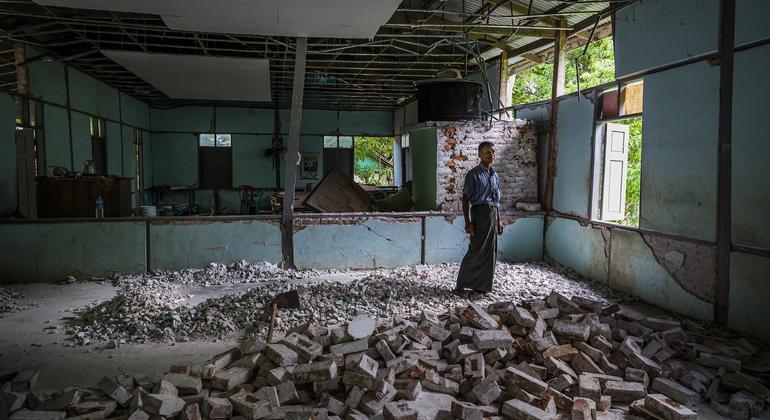The March 28 earthquake that measures 7.7 on the Richter scale, hit the central regions with mortal force, killing about 3,800 people and wounding more than 5,000, according to UN estimates.
The disaster devastated the infrastructure and the houses in Mandalay, Sagaing and Magway, displacing tens of thousands in a country that already deal with more than 3.2 million internal displaced people (IDP) from the Military coup of 2021.
“The communities are still recovering from the earthquakes: the strongest that the country has experienced in a century,“Said Jorge Moreira Da Silva, executive director of the UN Project Services Office (UNOPS), speaking with journalists from the UN headquarters in New York through a Beijing video after a three -day visit to Myanmar.
“The devastation caused by earthquakes aggravated the existing challenges of conflict, displacement and severe humanitarian needs.“
You need higher resources
Unops, which maintains the largest presence of the UN in Myanmar with almost 500 employees, mobilized $ 25 million within a few weeks of the disaster and has reached half a million people with support to save lives.
“My colleagues quickly worked with partners to deliver emergency shelters, clean water and deploy infrastructure specialists for fast evaluations,” said Da Silva.
However, he warned that much larger international support is needed to meet the scale of needs.
The World Bank estimates total damage in almost $ 11 billion, and it is expected that complete reconstruction costs two or three more times. More than 2.5 million tons of debris must also be clear to allow recovery.
Mr. Da Silva emphasized that reconstruction must be focused on people, inclusive and linked to peace consolidation efforts.
“We echo the UN calls for the end of violence,” he said. “Recovery and reconstruction must support Myanmar’s trip towards peace and reconciliation. The protection of civilians must be a priority.“
Women and girls face disproportionate risks
The humanitarian consequences have hit women and girls particularly hard, many of which were among those killed or injured, and now face risks of growing protection.
According to the United Nations Reproductive Health Agency, UNFPA, more than 4.6 million women of reproductive age, including more than 220,000 currently pregnant women, have a higher risk.
The damage to the health centers, worsened by the floods of the Monzones and the insecurity, has interrupted access to the obstetric care of emergency and menstrual hygiene. Meanwhile, gender -based violence is increasing sharply in overpopulated and poorly enlightened shelters.
The Executive Director of the UNOPS, Jorge Moreira, Da Silva meets with a woman and her newborn son in a health clinic.
Under pressure health system
He Risk of diseases transmitted by water such as cholera and diseases transmitted by vectors such as dengue and malaria are also increasing.
According to the World Health Organization (WHO), although important outbreaks had not been reported as of May 31, cases of aqueous diarrhea and skin infections are increasing.
The rains of the monsoon have worsened the conditions in temporary shelters, where the overcrowding and poor sanitation pose serious health concerns. Mental health is still fragile, with 67 percent of respondents in a recent survey that informs emotional anguish linked to the earthquake and ongoing conflict.
WHO and its partners have delivered more than 300,000 doses of vaccines, including tetanus and rage, but access remains limited, and underfined health services.
Prolonged crisis
More than 3.25 million people remain displaced within Myanmar from the February Military Coup, 2021, with at least 176,000 that seek refuge in neighboring countries, according to the refugee agency, UNHCR.
This excludes the hundreds of thousands of Rohingya refugees from previous waves of violence.
Myanmar also remains one of the most mortal countries in the world for land mines and explosive remains of war.
Only in the first nine months of 2024, 889 victims were reported, increasing the fear that the toll can exceed 1,052 deaths and documented injuries in 2023.




